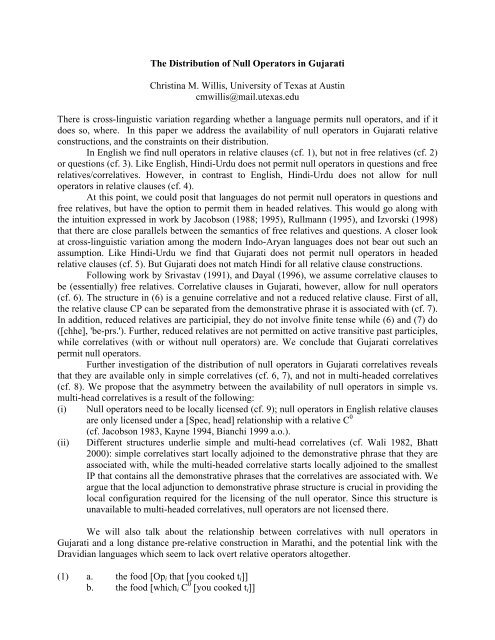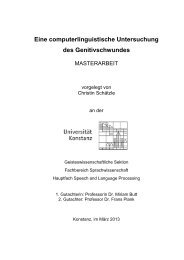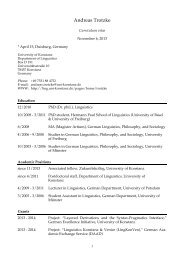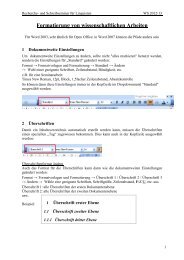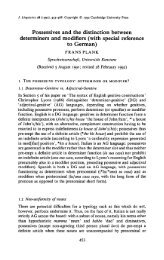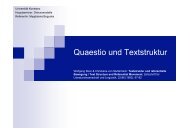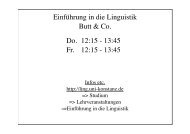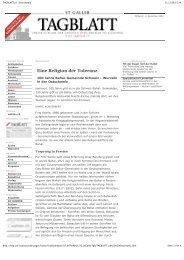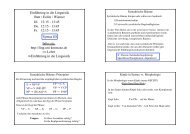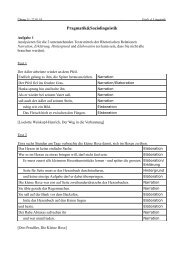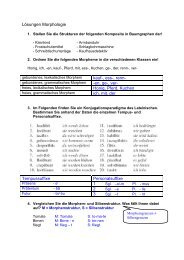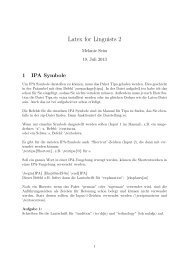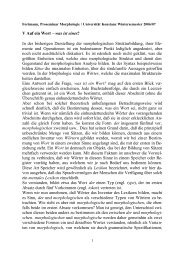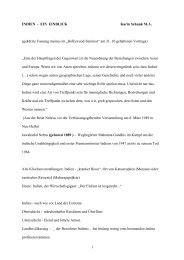The Distribution of Null Operators in Gujarati Christina M. Willis ...
The Distribution of Null Operators in Gujarati Christina M. Willis ...
The Distribution of Null Operators in Gujarati Christina M. Willis ...
You also want an ePaper? Increase the reach of your titles
YUMPU automatically turns print PDFs into web optimized ePapers that Google loves.
<strong>The</strong> <strong>Distribution</strong> <strong>of</strong> <strong>Null</strong> <strong>Operators</strong> <strong>in</strong> <strong>Gujarati</strong><br />
Christ<strong>in</strong>a M. <strong>Willis</strong>, University <strong>of</strong> Texas at Aust<strong>in</strong><br />
cmwillis@mail.utexas.edu<br />
<strong>The</strong>re is cross-l<strong>in</strong>guistic variation regard<strong>in</strong>g whether a language permits null operators, and if it<br />
does so, where. In this paper we address the availability <strong>of</strong> null operators <strong>in</strong> <strong>Gujarati</strong> relative<br />
constructions, and the constra<strong>in</strong>ts on their distribution.<br />
In English we f<strong>in</strong>d null operators <strong>in</strong> relative clauses (cf. 1), but not <strong>in</strong> free relatives (cf. 2)<br />
or questions (cf. 3). Like English, H<strong>in</strong>di-Urdu does not permit null operators <strong>in</strong> questions and free<br />
relatives/correlatives. However, <strong>in</strong> contrast to English, H<strong>in</strong>di-Urdu does not allow for null<br />
operators <strong>in</strong> relative clauses (cf. 4).<br />
At this po<strong>in</strong>t, we could posit that languages do not permit null operators <strong>in</strong> questions and<br />
free relatives, but have the option to permit them <strong>in</strong> headed relatives. This would go along with<br />
the <strong>in</strong>tuition expressed <strong>in</strong> work by Jacobson (1988; 1995), Rullmann (1995), and Izvorski (1998)<br />
that there are close parallels between the semantics <strong>of</strong> free relatives and questions. A closer look<br />
at cross-l<strong>in</strong>guistic variation among the modern Indo-Aryan languages does not bear out such an<br />
assumption. Like H<strong>in</strong>di-Urdu we f<strong>in</strong>d that <strong>Gujarati</strong> does not permit null operators <strong>in</strong> headed<br />
relative clauses (cf. 5). But <strong>Gujarati</strong> does not match H<strong>in</strong>di for all relative clause constructions.<br />
Follow<strong>in</strong>g work by Srivastav (1991), and Dayal (1996), we assume correlative clauses to<br />
be (essentially) free relatives. Correlative clauses <strong>in</strong> <strong>Gujarati</strong>, however, allow for null operators<br />
(cf. 6). <strong>The</strong> structure <strong>in</strong> (6) is a genu<strong>in</strong>e correlative and not a reduced relative clause. First <strong>of</strong> all,<br />
the relative clause CP can be separated from the demonstrative phrase it is associated with (cf. 7).<br />
In addition, reduced relatives are participial, they do not <strong>in</strong>volve f<strong>in</strong>ite tense while (6) and (7) do<br />
([chhe], 'be-prs.'). Further, reduced relatives are not permitted on active transitive past participles,<br />
while correlatives (with or without null operators) are. We conclude that <strong>Gujarati</strong> correlatives<br />
permit null operators.<br />
Further <strong>in</strong>vestigation <strong>of</strong> the distribution <strong>of</strong> null operators <strong>in</strong> <strong>Gujarati</strong> correlatives reveals<br />
that they are available only <strong>in</strong> simple correlatives (cf. 6, 7), and not <strong>in</strong> multi-headed correlatives<br />
(cf. 8). We propose that the asymmetry between the availability <strong>of</strong> null operators <strong>in</strong> simple vs.<br />
multi-head correlatives is a result <strong>of</strong> the follow<strong>in</strong>g:<br />
(i) <strong>Null</strong> operators need to be locally licensed (cf. 9); null operators <strong>in</strong> English relative clauses<br />
are only licensed under a [Spec, head] relationship with a relative C 0<br />
(cf. Jacobson 1983, Kayne 1994, Bianchi 1999 a.o.).<br />
(ii) Different structures underlie simple and multi-head correlatives (cf. Wali 1982, Bhatt<br />
2000): simple correlatives start locally adjo<strong>in</strong>ed to the demonstrative phrase that they are<br />
associated with, while the multi-headed correlative starts locally adjo<strong>in</strong>ed to the smallest<br />
IP that conta<strong>in</strong>s all the demonstrative phrases that the correlatives are associated with. We<br />
argue that the local adjunction to demonstrative phrase structure is crucial <strong>in</strong> provid<strong>in</strong>g the<br />
local configuration required for the licens<strong>in</strong>g <strong>of</strong> the null operator. S<strong>in</strong>ce this structure is<br />
unavailable to multi-headed correlatives, null operators are not licensed there.<br />
We will also talk about the relationship between correlatives with null operators <strong>in</strong><br />
<strong>Gujarati</strong> and a long distance pre-relative construction <strong>in</strong> Marathi, and the potential l<strong>in</strong>k with the<br />
Dravidian languages which seem to lack overt relative operators altogether.<br />
(1) a. the food [Opi that [you cooked ti]]<br />
b. the food [whichi C 0 [you cooked ti]]
(2) a. I ate [[what] i [you cooked ti]]<br />
b. *I ate [Op i you cooked ti]<br />
(3) a. [What] i did you cook ti?<br />
b. *Op i did you cook ti?<br />
(4) vo laRkii [*(jo) khaRii hai] laambi hai<br />
DEM girl *(REL) stand<strong>in</strong>g-f. is tall-f. is<br />
'<strong>The</strong> girl who is stand<strong>in</strong>g is tall.' (Srivastav, 1991; Dayal, 1996)<br />
(5) te chhokri [*(je) laambi chhe] ubhi chhe<br />
DEM girl *(REL) stand<strong>in</strong>g-f. is tall-f. is<br />
'<strong>The</strong> girl who is stand<strong>in</strong>g is tall.'<br />
<strong>The</strong> demonstrative phrase associated with the correlative CP <strong>in</strong> (6-9) is <strong>in</strong> bold.<br />
(6) [φREL-XP ubhi chhe] [te chhokri laambi chhe]<br />
stand<strong>in</strong>g-f. is DEM girl tall-f. is<br />
'<strong>The</strong> girl stand<strong>in</strong>g is tall'. (Literal: [(who) is stand<strong>in</strong>g], that girl is tall)<br />
(7) a. [je chhokro Sita sathe vat kari rahyo chhe], [Rita-ne te chhokro game chhe]<br />
REL boy Sita with talk do PROG is Rita-DAT DEM boy like is<br />
'Rita likes the boy who is talk<strong>in</strong>g to Sita.'<br />
b. [φREL-XP Sita sathe vat kari rahyo chhe], [Rita-ne te chhokro game chhe]<br />
Sita with talk do PROG is Rita-DAT DEM boy like is<br />
'Rita likes the boy who is talk<strong>in</strong>g to Sita.'<br />
(Literal: [(which boy) is talk<strong>in</strong>g to Sita], Rita likes that boy.)<br />
(8) a. [je chhokrae je chhokr<strong>in</strong>e joi] [te chhokra-e te chhokri-ne pasand kari]<br />
REL boy-ERG REL girl-ACC saw DEM boy-ERG DEM girl-ACC like did<br />
Literal: Which boy saw which girl, that boy liked that girl.<br />
b. *[φREL-XPi φREL-XPj joi] [te chhokra-e te chhokri-ne pasand kari]<br />
see-pst. DEM boy-ERG DEM girl-ACC like did<br />
(9) a. the book Op that John likes<br />
b. the book whose/*Op author C 0 John likes<br />
SELECTED REFERENCES<br />
Bhatt, R. (2000). "Locality <strong>in</strong> Apparently non-local Relativization: Correlatives <strong>in</strong> the<br />
Modern Indo-Aryan Languages," In Press.<br />
Cardona, G. (1965). A <strong>Gujarati</strong> Reference Grammar, <strong>The</strong> University <strong>of</strong> Pennsylvania<br />
Press, Philadelphia.<br />
Dayal, V. (1996). Locality <strong>in</strong> Wh-quantification: Questions and Relative Clauses <strong>in</strong><br />
H<strong>in</strong>di, Studies <strong>in</strong> L<strong>in</strong>guistics and Philosophy 62, Kluwer, Dordrecht.<br />
Jacobson, P. (1988) '<strong>The</strong> Syntax and Semantics <strong>of</strong> Free Relatives,' paper presented at<br />
LSA W<strong>in</strong>ter Meet<strong>in</strong>g, New Orleans.<br />
Srivastav, V. (1991). "<strong>The</strong> syntax and semantics <strong>of</strong> correlatives," Natural Language and<br />
L<strong>in</strong>guistic <strong>The</strong>ory 9, 637-686.<br />
Wali, K. (1982). ``Marathi Correlatives: a conspectus,’’ <strong>in</strong> P.J. Mistry, ed. South Asian<br />
Review: studies <strong>in</strong> South Asian Languages and L<strong>in</strong>guistics, SALA Journal 6.1,<br />
South Asian Literary Association, Jacksonville, Florida, 78-88.


